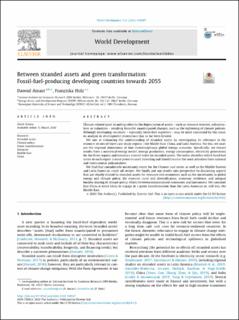| dc.contributor.author | Ansari, Dawud | |
| dc.contributor.author | Holz, Franziska | |
| dc.date.accessioned | 2020-08-25T07:08:32Z | |
| dc.date.available | 2020-08-25T07:08:32Z | |
| dc.date.created | 2020-04-23T10:58:14Z | |
| dc.date.issued | 2020 | |
| dc.identifier.citation | World Development. 2020, 130 | en_US |
| dc.identifier.issn | 0305-750X | |
| dc.identifier.uri | https://hdl.handle.net/11250/2673756 | |
| dc.description.abstract | Climate-related asset stranding refers to the depreciation of assets – such as resource reserves, infrastructure, or industries – resulting from the unanticipated changes, such as the tightening of climate policies. Although developing countries – especially fossil-fuel exporters – may be most concerned by this issue, its analysis in development (economics) has so far been limited.
We aim at enhancing the understanding of stranded assets by investigating its relevance in the resource sectors of three case study regions –the Middle East, China, and Latin America. For this, we analyse the regional dimensions of four interdisciplinary global energy scenarios. Specifically, we extract results from a numerical energy model (energy production, energy consumption, electricity generation) for the three regions and introduce a novel index for stranded assets. The index identifies which fossil fuel sector in each region is most prone to asset stranding and should receive the most attention from national and international policymakers.
We find that considerable uncertainty exists for the Chinese coal sector as well as the Middle Eastern and Latin American crude oil sectors. We finally put our results into perspective by discussing aspects that are closely related to stranded assets for resource-rich economies such as the uncertainty in global energy and climate policy, the resource curse and diversification, economic resilience, and unequal burden-sharing of climate policy efforts between industrialised economies and latecomers. We conclude that China is more likely to engage in a green transformation than the Latin Americas or, still less, the Middle East. | en_US |
| dc.language.iso | eng | en_US |
| dc.publisher | Elsevier | en_US |
| dc.rights | Navngivelse 4.0 Internasjonal | * |
| dc.rights.uri | http://creativecommons.org/licenses/by/4.0/deed.no | * |
| dc.title | Between stranded assets and green transformation: Fossil-fuel-producing developing countries towards 2055 | en_US |
| dc.type | Peer reviewed | en_US |
| dc.type | Journal article | en_US |
| dc.description.version | publishedVersion | en_US |
| dc.source.volume | 130 | en_US |
| dc.source.journal | World Development | en_US |
| dc.identifier.doi | 10.1016/j.worlddev.2020.104947 | |
| dc.identifier.cristin | 1807647 | |
| dc.description.localcode | Climate-related asset stranding refers to the depreciation of assets – such as resource reserves, infrastructure, or industries – resulting from the unanticipated changes, such as the tightening of climate policies. Although developing countries – especially fossil-fuel exporters – may be most concerned by this issue, its analysis in development (economics) has so far been limited. We aim at enhancing the understanding of stranded assets by investigating its relevance in the resource sectors of three case study regions –the Middle East, China, and Latin America. For this, we analyse the regional dimensions of four interdisciplinary global energy scenarios. Specifically, we extract results from a numerical energy model (energy production, energy consumption, electricity generation) for the three regions and introduce a novel index for stranded assets. The index identifies which fossil fuel sector in each region is most prone to asset stranding and should receive the most attention from national and international policymakers. We find that considerable uncertainty exists for the Chinese coal sector as well as the Middle Eastern and Latin American crude oil sectors. We finally put our results into perspective by discussing aspects that are closely related to stranded assets for resource-rich economies such as the uncertainty in global energy and climate policy, the resource curse and diversification, economic resilience, and unequal burden-sharing of climate policy efforts between industrialised economies and latecomers. We conclude that China is more likely to engage in a green transformation than the Latin Americas or, still less, the Middle East. | en_US |
| cristin.ispublished | true | |
| cristin.fulltext | original | |
| cristin.qualitycode | 2 | |

